USACE’s Steve Stockton: The Urgent Need to Transform US Water Resources Infrastructure
Navigation channels that support international trade and produce one-third of U.S. Gross Domestic Product (GDP), almost 14 million jobs, flood-risk reduction that prevents $22.3 billion in average annual damages, $800 million in clean hydropower, water supply storage for 55 million households and water-based recreation opportunities, which one out of every 10 Americans enjoy annually, are examples of the value the U.S. Army Corps of Engineers (USACE) brings to the Nation. Unfortunately, most Americans are unaware that the country’s degraded water resources infrastructure is putting all this at risk and jeopardizing a quality of life that cannot be measured in dollars.
According to USACE Director of Civil Works, Steve Stockton, “We built our water resources infrastructure in the last century and assumed it would last forever. Guess what? It doesn’t. America’s locks, dams, levees and other inventory maxed out in value at about $237 billion back in the 1980s. Since we haven’t recapitalized, and it has depreciated, it’s now worth about $164 billion. So, it’s easy to see the problem. What we’re doing is unsustainable, and if one looks at the indicators in terms of reliability, such as unscheduled outages, it’s like looking at the family car. If there are no plans to buy a new one, the family will be driving the same car forever.”
USACE plans, designs, constructs, operates and maintains America’s water resources infrastructure, which is in a state of decline due to the widening investment gap between resources needed and available funding. As a result, the Corps is aggressively pursuing a sustainable strategy for stewardship of this vital portfolio and asking for assistance from its stakeholders and the public in order to create a shared responsibility with reliable solutions to address the Nation’s needs. Stockton maintains that a “false sense of security seems to exist about the Nation’s water resources infrastructure, which is wearing out faster than it’s being replaced or rehabilitated.”
America can no longer afford to invest in infrastructure that either doesn’t meet its needs or whose cost is greater than its value, which is why a transformation that provides for priority national services is required.
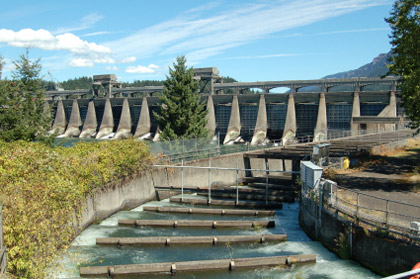
© iStockphoto.com/JerryPDX|This fish ladder allows salmon to swim upstream through the Bonneville Dam on the Columbia River in Oregon.
In addition, USACE recognizes the need, according to Stockton, “to implement holistic, integrated and sustainable solutions focused at the watershed and systems level.” Aging infrastructure is leading to increased risk of failure and services are becoming unreliable. This not only increases risks to public safety, environment and economy but also has regional and national security implications. Therefore, says Stockton, “time is of the essence to adopt a new sustainable strategy” that also supports risk reduction for future generations as well as risk reduction under climate variability.
“In every report the Corps puts out, we try to tell the truth about the state of America’s infrastructure – what’s happening to it and the fact that there’s no long-term recapitalization plan. The Trust Funds aren’t viable for different reasons. The Inland Waterways Trust Fund isn’t working because not enough money is going into it. With respect to the Harbor Maintenance Trust Fund, although $1.4-1.5 billion goes into that fund annually, the Office of Management and Budget (OMB) considers those funds to be general revenue, and the Corps only gets about one-half of that back to use for its intended purpose. What we’re doing with our water resources infrastructure is unsustainable, but USACE has to have a plan since we’re responsible for the Nation’s investment. So, I’m outlining our infrastructure strategy as well as the value to the Nation provided by America’s water resources infrastructure so everyone knows what’s at stake,” says Stockton.
Reasons for Change
For infrastructure to perform well under climate variability, explains the Civil Works Director, significant investment is required for modernization. Heavier rain events threaten flood risk management, such as levees, and sea level rise affects coastal navigation, structures and ecosystems. Increasing drought and population create water scarcity, thus placing additional stress on existing water supply and infrastructure like hydropower capacity.
Augmenting these concerns is the American Society of Civil Engineers’ 2009 Report Card for America’s Infrastructure, which gave the Nation’s dams a “D,” its inland waterways a “D-” and its levees a “D-.” Twenty-five percent of flood risk management structures are either unsafe or potentially unsafe, according to USACE. Stockton says this degradation “has been many decades in the making and is the result of four primary factors,” which are elucidated below:
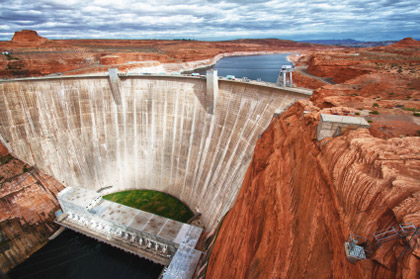
© iStockphoto.com/AlexeyKamenskiy | A view of the Glen Dam in Page, Arizona.
1. Aging Infrastructure – The majority of U.S infrastructure was built between the 1920s and 1980s, and has already reached or exceeded its useful life. Water resources infrastructure kept pace with population growth until the mid-1980s when investment was insufficient to keep the infrastructure in good working order.
2. Increasing Demands – Stockton says USACE “operating demands have grown and changed throughout the past 30 years while maintenance and repair funding have remained about the same.” Fiscal year 2012 urgent operations and maintenance backlog is now $1.01 billion, which is an increase of $127 million from 2011 and an increase of $200 million from 1998.
3. Fiscal Constraints – Federal funding has remained flat in nominal terms and declined in real terms. “Recent supplemental funding increases have, for the most part, only restored capabilities lost due to damage from major events, such as Hurricane Katrina and the 2011 significant flood events across the Mississippi River, Missouri River and other parts of the country,” maintains Stockton.
4. New 21st Century Challenges – Shifting demographics, climate variability and globalization are increasing demands on an already stressed infrastructure. For instance, U.S. population growth is not only increasing but also becoming more urbanized and concentrated in coastal areas with increased risk of severe weather events. In addition, arid regions that already face limited availability of fresh water are experiencing increased population growth.
Value & Risks
USACE water resources mandates and responsibilities include navigation, flood risk management, environment and recreation, hydropower and water supply. Its portfolio of 1,600 civil works projects spans all 50 states.
Navigation – Ports & Harbors. The Corps maintains 926 shallow and deep draft harbors with 250 harbors handling more than 250,000 tons of cargo annually. More than 95 percent of overseas trade moves in and out of the U.S. by ship. In order to accommodate this trade, more than 90 percent of the Nation’s 50 busiest ports require maintenance dredging to allow access for larger vessels and their cargo volume.
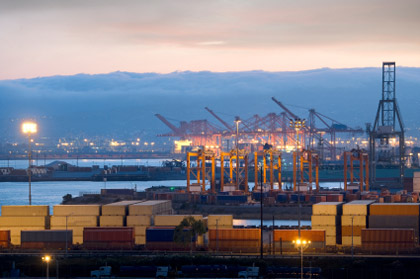
© iStockphoto.com/kevinjeon00 | Industrial harbor with cranes and cargo containers.
To date almost 30 percent of vessel calls at U.S. ports are constrained due to inadequate channel depths, which translates into higher transportation costs. “Recent global rankings by the World Economic Forum place the U.S at 23rd in port infrastructure quality,” says Stockton, which is down from 13th just two years ago (Global Competitiveness Report 2012).
Navigation – Inland Waterways. USACE operates 12,000 of the Nation’s 25,000 miles of inland and intracoastal waterways with 207 lock chambers at 171 sites through which 630 million tons of products and material move annually. Nearly 50 percent of USACE locks on inland waterways are more than 50 years old, thus operating beyond their design life with overall reliability declining. Scheduled lock outages for maintenance and repair are increasing while unscheduled lock outages are increasing. In fiscal year 1993 approximately 2.5 percent of locks were unavailable; that number rose to 8 percent in fiscal year 2011. Stockton maintains that postponing waterway modernization projects “is costing the U.S. $7 billion in lost economic value.” In addition, more than 800,000 Americans depend on the inland waterway system for their jobs, which equates to a $2 billion annual payroll.
Flood Risk Management. The Corps manages 11,750 miles of levee systems and 692 dams, which prevent $22.3 billion in average annual flood damage ($42.3 billion in 2007). Initial screening of 167 dams under USACE’s Dam Safety Program’s Screening Portfolio Risk Analysis (SPRA) classifies 25 percent of flood damage reduction projects as unsafe or potentially unsafe. Ten million U.S. households, nearly 94 million acres of land and $800-900 billion in property are situated in floodplains and at risk for flooding. More than $3 trillion in infrastructure along the East and Gulf Coast shorelines is vulnerable to flooding. In addition, according to Stockton, climate change may cause more extreme weather events, which could further impact USACE flood risk reduction systems.
Environment. USACE manages 12 million acres of rivers, lakes and adjacent lands in 43 states, including valuable coastal areas in every state. Since 2005, it has restored 73,800 acres to a less degraded, more natural state. The Corps also regulates wetlands, which are home to more than one-third of all federally listed rare and endangered species. Stockton says USACE Environmental Operating Principles advocate use of green ethics in all Corps projects because failure to do so can compromise air and water purity, soil fertility, natural habitats, threatened and endangered species, and flood management efforts. The Civil Works Director also explains that failure to implement a watershed systems approach, at even small project levels, “can lead to degraded ecosystems.” Nearly 50 state and federal fish hatcheries, 200 state wildlife management areas, 25 federal wildlife refuges and more than 150 state parks are associated with Corps lands and waters.

© iStockphoto.com/mtilghma
|A Tri-Colored Heron hunting in the Everglades.
Recreation. USACE manages 54,874 miles of lake shoreline with 370 million recreational visitors annually. Stockton says this is more visitors than Disney and the U.S. Park Service receive. These visits produce $16 billion in economic activity, support 270,000 jobs and provide untold value in annual water safety and environmental education. The average USACE recreation facility is 45 years old with more than 1,200 sites 50 years old or more. Stockton maintains that services impacting visitor safety and quality of experience, “such as ranger patrols and cleaning of public facilities, are below acceptable levels of service at facilities with 53 percent of total annual visitations.” Degraded infrastructure and constrained funding mean some sites will close while others experience decreased hours of availability. In fiscal year 2012 these reductions will equate to 13 million fewer visits and $330 million in decreased spending – dollars that could have supported 2,400 jobs and generated more than $65 million in local community personal income.
Hydropower. USACE is the largest owner/operator of hydroelectric power plants in the U.S. and one of the largest in the world with 75 facilities, 353 generating units and 20,475 megawatts-rated generating capacity producing more than 100 billion kilowatt-hours per year. The 20 plants on the Columbia, Snake and Missouri rivers provide 36 percent of total electric capacity in the Pacific Northwest region and 9 percent in the Missouri River region. Median age of all USACE hydropower plants is 43 years with the majority designed to function optimally for only 35 years. Aging hydropower plants are at higher risk for outages, explains Stockton, and “in recent years availability of generating units during peak power demand periods has fallen to more than 10 percent below the national industry standard.” Outage hours have increased by 25 percent since 1999 with 200,000 during that fiscal year and an almost every year rise to 500,000 outage hours in fiscal year 2011.
Water Supply. USACE maintains almost 700 reservoirs and 9.76 million acre-feet of municipal and industrial water supply storage with an $800 million annual contribution to the U.S. economy. Within the last 13 years, the Corps has seen a steady increase in number of acre-feet of water storage under water supply contract in part due to demographic shifts in the west (Nevada and Arizona alone had a 66 and 40 percent growth, respectively, from 1990-2000), southwest and southeast. Stockton says water scarcity due to climatic influences “has the potential to impact future reliability of these water supplies in some areas of the country.” Failures can severely impact municipal, industrial and agricultural needs and can even lead to national security concerns. The Nation’s $1.5 billion investment in water supply storage is at risk if the infrastructure fails or fails to perform as designed.
Sustainable Transformation Initiatives
According to Stockton, USACE’s intention to support a sustainable infrastructure strategy is “deliberate in order to shed old concepts and processes to become better prepared for the challenges posed by an uncertain future.” As part of this effort, the Civil Works Director spent time explaining the Corps’ four complimentary initiatives. They include:
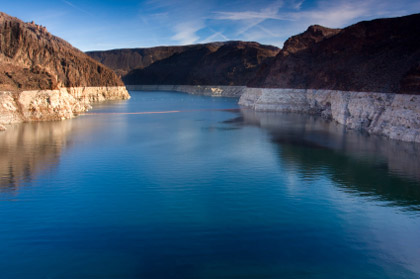
© iStockphoto.com/wholden|Lake Mead, which was created by a dam on the Colorado River at the border of Arizona and Nevada, observed from Hoover Dam.
1. Budget – USACE intends to implement a comprehensive and integrated revitalization plan that explores, seeks and utilizes alternative financing options while supporting risk-informed decision-making to prioritize infrastructure based on value to the Nation. A long-term strategy for infrastructure retirement or revitalization will provide workable solutions and mitigate the current infrastructure crisis while allowing capacity for sustainable growth. Alternative financing options include Public Private Partnerships (PPP), User Fee Enhancements and Infrastructure Banks. Infrastructure prioritization will focus on investments that generate significant economic benefits, reduce public safety risks, improve human health or restore nationally significant aquatic ecosystems with choices made transparently.
“Now that we don’t have earmarks, we’re trying to be more focused and deliberate. We’re trying to put the money where we can get the highest return and output in order to bring projects online and have them start producing sooner. The Corps is getting 5 percent per year reductions, which means we’re doing less with less. We have a $60 billion backlog in authorized projects and receive only $1-2 billion per year to chip away at that, which doesn’t allow for much progress.
“We’re getting some traction with alternate financing – looking at other revenue streams to do what’s expected of us, what we’re authorized to do but don’t have funding to do. Although we would need authority for tolls and things of that nature, those type things are exactly what we’re looking at. We’ve had three infrastructure workshops. We’ve brought in private industry architects and engineers, construction firms, private equity firms and retirement funds to see how we can we bring in other funding to still perform the authorized services but have someone else pay for it,” explains Stockton.
2. Planning – The Civil Works Director says USACE is “trying to make its planning process relevant to the 21st Century because it’s long, frustrating, expensive and not meeting the Nation’s needs.” New concepts for streamlining preauthorization include the “3x3x3” rule, meaning target cost for a feasibility report will be no greater than $3 million, take no longer than three years, utilize all three levels of USACE’s vertical teams and create reports less than 100 pages.
The Corps will also consider integrated systems, regions and watersheds and choose planning projects with direct consideration of national priorities. This approach will shift decision-making to an interdependent system with regional and long-term solutions that consider the entire life-cycle of projects and are linked to high-priority national needs and sustainable strategies. Stockton says a reset and reclassification process is underway to focus on studies with the most likelihood for success and that are the most credible and reliable projects for congressional authorizations.

© iStockphoto.com/tothemoonphoto | USACE water resources provides water for irrigation for a rancher’s crops in the western U.S.
3. Asset Management – Stockton says USACE is trying to manage the assets it has by “making the best possible investments on each system to reduce risk using risk-informed decision-making.” To this end, the Corps is shaping a sustainable portfolio that supplies reliable services, uses improved performance metrics and explores adaptable infrastructure and green solutions to reduce long-term maintenance costs. Adaptive management promotes flexible decision-making that can be adjusted to respond to risks and uncertainties. Problems and issues will consider “green” and more environmentally sensitive alternatives, or Mother Nature, in providing solutions.
“Also, you insert a decision-point toward the end of a life-cycle to make a choice as to whether the project should undergo recapitalization, be re-purposed, de-authorized or transferred to a willing and empowered local sponsor. In other words, is there someone else who wants to take it over, or do you mothball it, take it out of service or decommission it?” explains Stockton.
4. Methods of Delivery – The Corps plans to modernize hydropower, pursue sustainable water development and management, integrate enhanced IT systems for improved communication and better tools, and deliver services through engineering delivery centers. USACE is participating with the Department of the Interior (DOI) on initiatives to deliver water services to the public more efficiently to ensure widespread acceptance and implementation of sustainable water development and management strategies. In addition, the Corps must ensure that its communications and technical engineering systems are state-of-the-art. Centers of expertise for engineering and other technical specialties will be increasingly used to help guarantee efficient and effective transfer of knowledge among technical specialties integral to USACE’s continued ability to provide state-of-the-art services.
According to Stockton, the Corps is committed to using sustainable strategies in every facet of its work from building the economy, protecting and restoring the environment, offering affordable recreation opportunities and ensuring flood risk reduction to providing water storage for municipal and industrial water supplies and agricultural irrigation. Water resources infrastructure is vital to the Nation: states, tribes, local governments and the public. Therefore, a shared responsibility exists. As such, the floor is open for input and an exchange of ideas, especially those with novel approaches. As USACE’s definition of success evolves, so will its efforts in pursuit of that success. Stakeholder and “listening sessions” will be held to provide opportunities for industry, local governments and the public to ask questions and to make suggestions. When the opportunity presents itself, be sure to join the dialogue because, as Stockton and the Corps so aptly explain, “A Nation is only as strong as its infrastructure.”
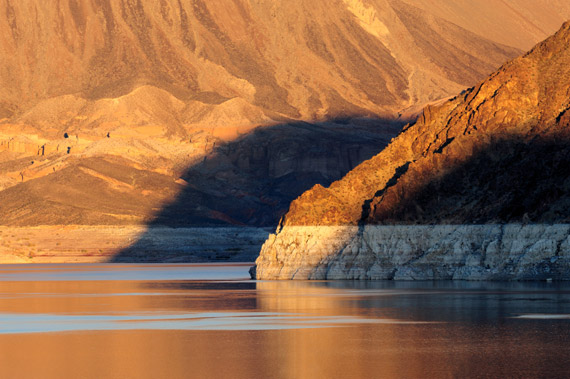
© iStockphoto.com/gnagel|Shadow of the canyon wall at Lake Mead National Recreational Area near Boulder City, Nev.




























